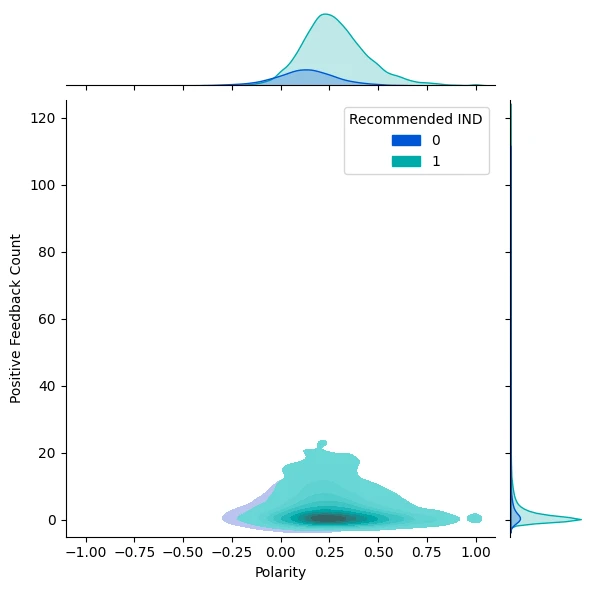
Plotly & Seaborn to Explore Text Dataset
- Plotly & Seaborn to Explore Text Dataset
Dataset
Women's E-Commerce Clothing Reviews
Content
This dataset includes 23486 rows and 10 feature variables. Each row corresponds to a customer review, and includes the variables:
- Clothing ID: Integer Categorical variable that refers to the specific piece being reviewed.
- Age: Positive Integer variable of the reviewers age.
- Title: String variable for the title of the review.
- Review Text: String variable for the review body.
- Rating: Positive Ordinal Integer variable for the product score granted by the customer from 1 Worst, to 5 Best.
- Recommended IND: Binary variable stating where the customer recommends the product where 1 is recommended, 0 is not recommended.
- Positive Feedback Count: Positive Integer documenting the number of other customers who found this review positive.
- Division Name: Categorical name of the product high level division.
- Department Name: Categorical name of the product department name.
- Class Name: Categorical name of the product class name.
import json
import cufflinks as cf
import matplotlib.pyplot as plt
import nltk
import numpy as np
import pandas as pd
import plotly as py
import seaborn as sns
from sklearn.feature_extraction.text import CountVectorizer
from textblob import TextBlob
from contractions import contractions
from plotly.offline import iplot
py.offline.init_notebook_mode(connected=True)
cf.go_offline()
! wget 'https://github.com/ya-stack/Women-s-Ecommerce-Clothing-Reviews/raw/master/Womens%20Clothing%20E-Commerce%20Reviews.csv' -P dataset
reviews_df = pd.read_csv('dataset/Womens_Clothing_E-Commerce_Reviews.csv')
reviews_df.head(5)
| Unnamed: 0 | Clothing ID | Age | Title | Review Text | Rating | Recommended IND | Positive Feedback Count | Division Name | Department Name | Class Name | |
|---|---|---|---|---|---|---|---|---|---|---|---|
| 0 | 0 | 767 | 33 | NaN | Absolutely wonderful - silky and sexy and comf... | 4 | 1 | 0 | Initmates | Intimate | Intimates |
| 1 | 1 | 1080 | 34 | NaN | Love this dress! it's sooo pretty. i happene... | 5 | 1 | 4 | General | Dresses | Dresses |
| 2 | 2 | 1077 | 60 | Some major design flaws | I had such high hopes for this dress and reall... | 3 | 0 | 0 | General | Dresses | Dresses |
| 3 | 3 | 1049 | 50 | My favorite buy! | I love, love, love this jumpsuit. it's fun, fl... | 5 | 1 | 0 | General Petite | Bottoms | Pants |
| 4 | 4 | 847 | 47 | Flattering shirt | This shirt is very flattering to all due to th... | 5 | 1 | 6 | General | Tops | Blouses |
Data Cleaning
reviews_df_drop= reviews_df.drop(labels=['Unnamed: 0', 'Clothing ID', 'Title'], axis=1)
reviews_df_drop.head(5)
| Age | Review Text | Rating | Recommended IND | Positive Feedback Count | Division Name | Department Name | Class Name | |
|---|---|---|---|---|---|---|---|---|
| 0 | 33 | Absolutely wonderful - silky and sexy and comf... | 4 | 1 | 0 | Initmates | Intimate | Intimates |
| 1 | 34 | Love this dress! it's sooo pretty. i happene... | 5 | 1 | 4 | General | Dresses | Dresses |
| 2 | 60 | I had such high hopes for this dress and reall... | 3 | 0 | 0 | General | Dresses | Dresses |
| 3 | 50 | I love, love, love this jumpsuit. it's fun, fl... | 5 | 1 | 0 | General Petite | Bottoms | Pants |
| 4 | 47 | This shirt is very flattering to all due to th... | 5 | 1 | 6 | General | Tops | Blouses |
reviews_df_drop.sum(numeric_only=True)
| Age | 1014561 |
| Rating | 98548 |
| Recommended IND | 19314 |
| Positive Feedback Count | 59559 |
| dtype: int64 |
reviews_df_drop.dropna(subset=['Review Text', 'Division Name'], inplace=True)
reviews_df_drop.sum(numeric_only=True)
Remove Contractions
' '.join(reviews_df_drop['Review Text'].tolist())
def expand_contractions(x):
if type(x) is str:
# remove backslashes
x = x.replace('\\', '')
# expand contractions
for key in contractions:
value = contractions[key]
x = x.replace(key, value)
return x
else:
return x
# test function on text
x = "y'all it\'s sooo pretty, i am 5\' 5\'\', about 135"
print(expand_contractions(x))
# you all it is sooo pretty, i am 5' 5'', about 135
# test on a dataframe
string_series = pd.Series([
"i\'m glad i did bc it\'s never...",
"I\'m 5\"5\' and ain't 125 lbs."
], dtype="string")
string_df = pd.DataFrame({'strings':string_series.values})
string_df['strings'].apply(lambda x: expand_contractions(x)).head(2)
# 0 I am glad i did because it is never...
# 1 I am 5"5' and is not 125 lbs.
# Name: strings, dtype: object
reviews_df_expanded = reviews_df_drop.copy()
reviews_df_expanded['Review Text'] = reviews_df_drop['Review Text'].apply(
lambda x: expand_contractions(x)
)
' '.join(reviews_df_expanded['Review Text'].tolist())
Feature Engineering
reviews_df_expanded['Polarity'] = reviews_df_expanded['Review Text'].apply(
lambda x: TextBlob(x).sentiment.polarity
)
reviews_df_expanded['Review Length'] = reviews_df_expanded['Review Text'].apply(
lambda x: len(x)
)
reviews_df_expanded['Word Count'] = reviews_df_expanded['Review Text'].apply(
lambda x: len(x.split())
)
def get_avg_word_len(x):
words = x.split()
word_len = 0
for word in words:
word_len = word_len + len(word)
return word_len/len(words)
reviews_df_expanded['Average Word Length'] = reviews_df_expanded['Review Text'].apply(
lambda x: get_avg_word_len(x)
)
reviews_df_expanded.head(5)
| Age | Review Text | Rating | Recommended IND | Positive Feedback Count | Division Name | Department Name | Class Name | Polarity | Review Length | Word Count | Average Word Length | |
|---|---|---|---|---|---|---|---|---|---|---|---|---|
| 0 | 33 | Absolutely wonderful - silky and sexy and comf... | 4 | 1 | 0 | Initmates | Intimate | Intimates | 0.633333 | 53 | 8 | 5.750000 |
| 1 | 34 | Love this dress! it is sooo pretty. i happen... | 5 | 1 | 4 | General | Dresses | Dresses | 0.339583 | 316 | 65 | 3.800000 |
| 2 | 60 | I had such high hopes for this dress and reall... | 3 | 0 | 0 | General | Dresses | Dresses | 0.073675 | 500 | 98 | 4.112245 |
| 3 | 50 | I love, love, love this jumpsuit. it is fun, f... | 5 | 1 | 0 | General Petite | Bottoms | Pants | 0.550000 | 125 | 23 | 4.478261 |
| 4 | 47 | This shirt is very flattering to all due to th... | 5 | 1 | 6 | General | Tops | Blouses | 0.512891 | 192 | 36 | 4.361111 |
Numerical Plots
Sentiment Polarity
reviews_df_expanded['Polarity'].iplot(
title='Sentiment Polarity',
theme='polar',
yTitle='Sentiment [-1,1]',
xTitle='Reviews'
)
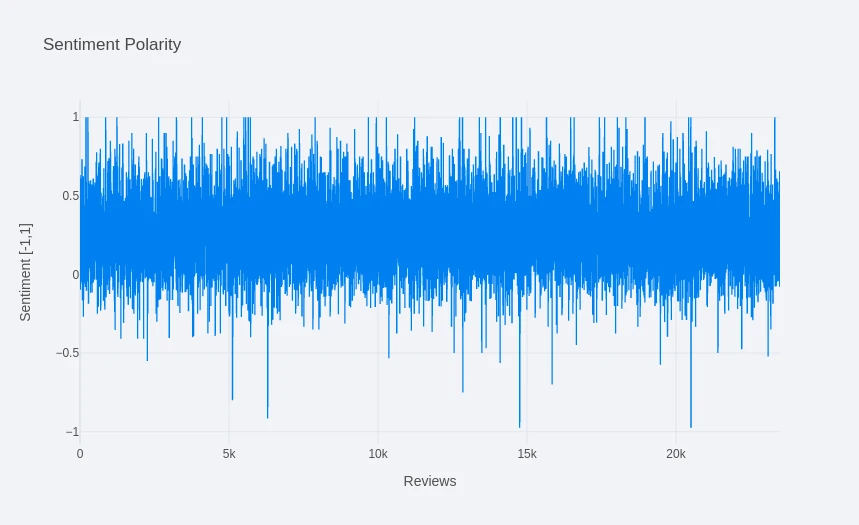
reviews_df_expanded['Polarity'].iplot(
kind='hist',
title='Sentiment Polarity',
theme='polar',
xTitle='Sentiment [-1,1]',
yTitle='Frequency'
)
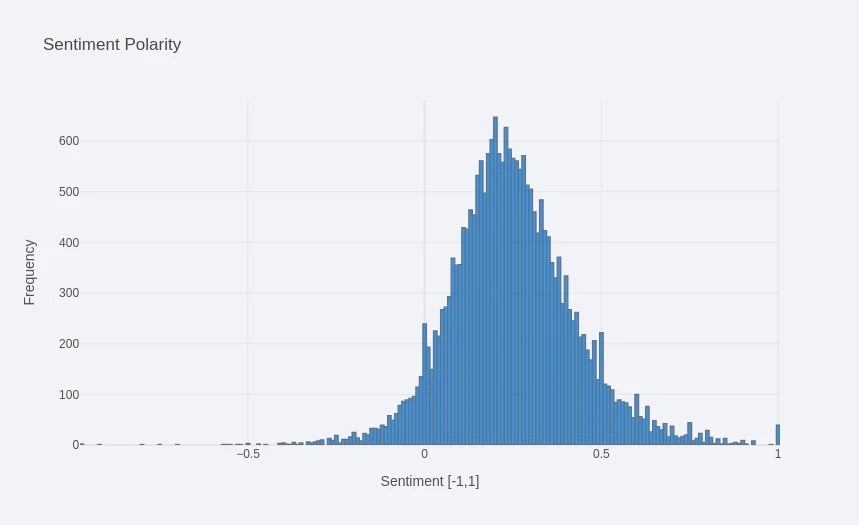
Ratings vs. Age
reviews_df_expanded['Rating'].iplot(
kind='hist',
theme='polar',
title='Rating Histogram',
xTitle='Rating',
yTitle='Frequency'
)
reviews_df_expanded['Age'].iplot(
kind='hist',
theme='polar',
title='Age Histogram',
xTitle='Age',
yTitle='Frequency'
)
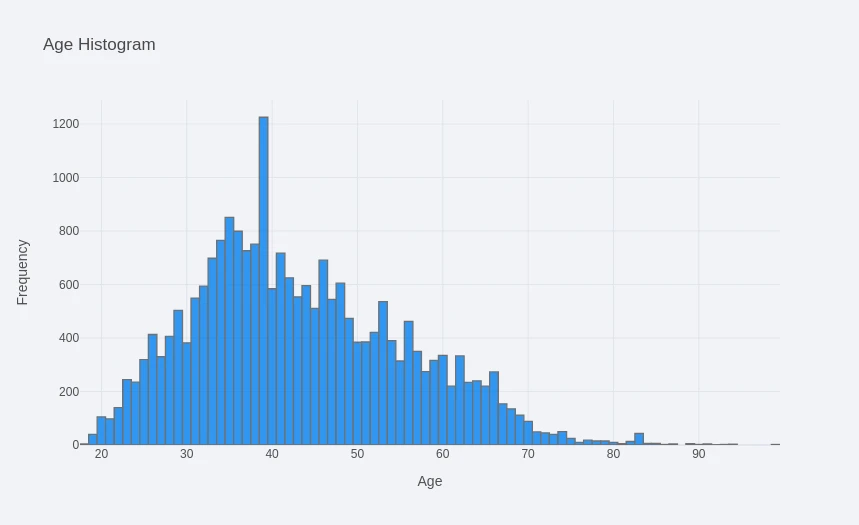
sns.jointplot(
data=reviews_df_expanded,
x='Age',
y='Polarity',
kind='scatter',
hue='Rating',
palette='winter',
alpha=0.4
)
plt.savefig('../assets/E-Commerce_Clothing_Reviews_05.webp', bbox_inches='tight')
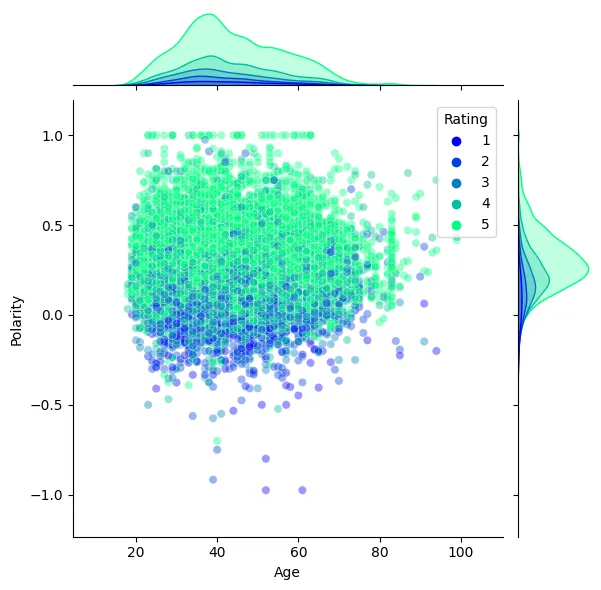
Word Count vs Average Word Length
reviews_df_expanded['Word Count'].iplot(
kind='hist',
theme='polar',
title='Word Count',
xTitle='Word Count',
yTitle='Frequency'
)
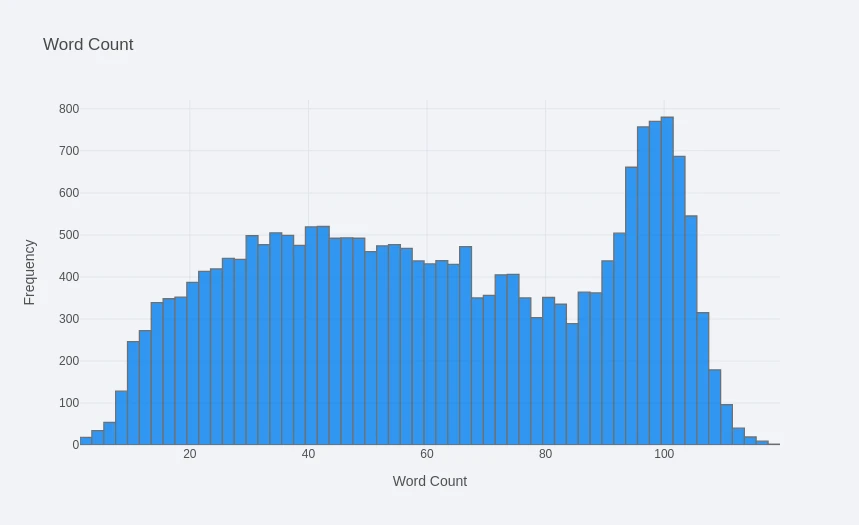
reviews_df_expanded['Average Word Length'].iplot(
kind='hist',
theme='polar',
title='Average Word Length',
xTitle='Average Word Length',
yTitle='Frequency'
)
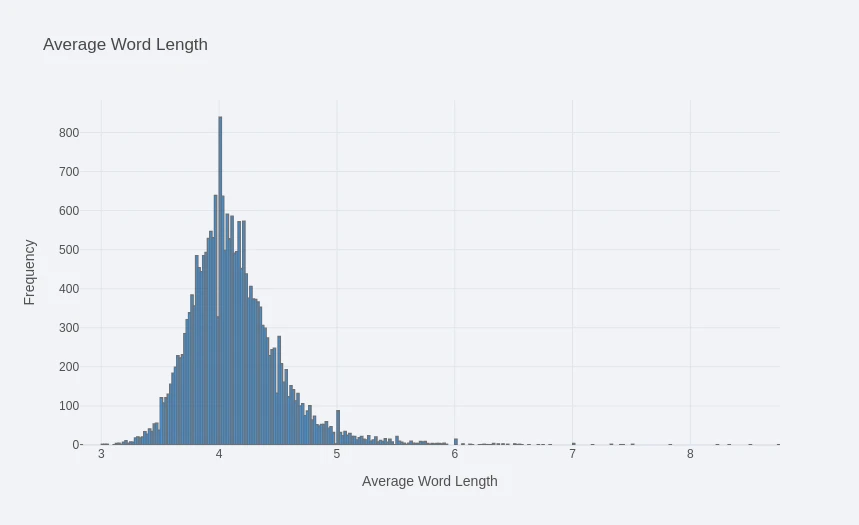
sns.jointplot(
data=reviews_df_expanded,
x='Word Count',
y='Average Word Length',
kind='scatter',
hue='Rating',
palette='winter',
alpha=0.4
)
plt.savefig('../assets/E-Commerce_Clothing_Reviews_08.webp', bbox_inches='tight')
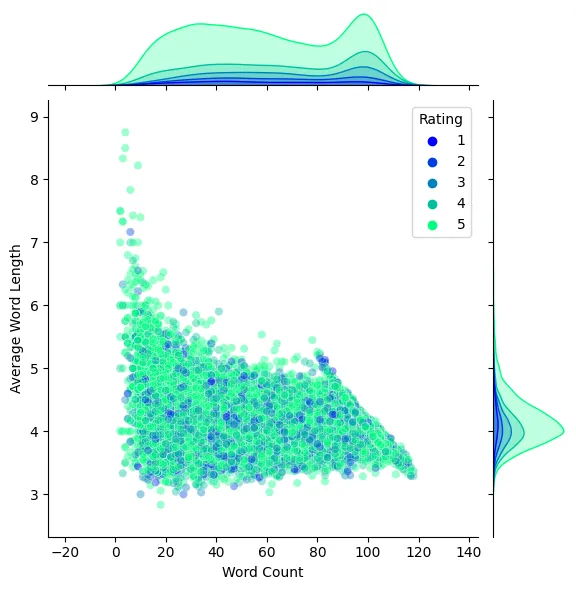
Categorical Plots
Department, Division and Class
departments = reviews_df_expanded['Department Name'].value_counts()
divisions = reviews_df_expanded['Division Name'].value_counts()
classes = reviews_df_expanded['Class Name'].value_counts()
| Class Names | Count | Division Name | Count | Department Name | Count |
|---|---|---|---|---|---|
| Dresses | 6145 | Tops | 10048 | General | 13365 |
| Knits | 4626 | Dresses | 6145 | General Petite | 7837 |
| Blouses | 2983 | Bottoms | 3662 | Initmates | 1426 |
| Sweaters | 1380 | Intimate | 1653 | ||
| Pants | 1350 | Jackets | 1002 | ||
| Jeans | 1104 | Trend | 118 | ||
| Fine gauge | 1059 | ||||
| Skirts | 903 | ||||
| Jackets | 683 | ||||
| Lounge | 669 | ||||
| Swim | 332 | ||||
| Outerwear | 319 | ||||
| Shorts | 304 | ||||
| Sleep | 214 | ||||
| Legwear | 158 | ||||
| Intimates | 147 | ||||
| Layering | 132 | ||||
| Trend | 118 | ||||
| Casual bottoms | 1 | ||||
| Chemises | 1 | ||||
| Name: Class Name, dtype: int64 |
reviews_df_expanded['Department Name'].value_counts().iplot(
kind='bar',
theme='polar',
title='Reviews by Department',
xTitle='Departments',
yTitle='Review Count'
)
reviews_df_expanded['Division Name'].value_counts().iplot(
kind='bar',
theme='polar',
title='Reviews by Division',
xTitle='Division',
yTitle='Review Count'
)
reviews_df_expanded['Class Name'].value_counts().iplot(
kind='bar',
theme='polar',
title='Reviews by Class',
xTitle='Class',
yTitle='Review Count'
)
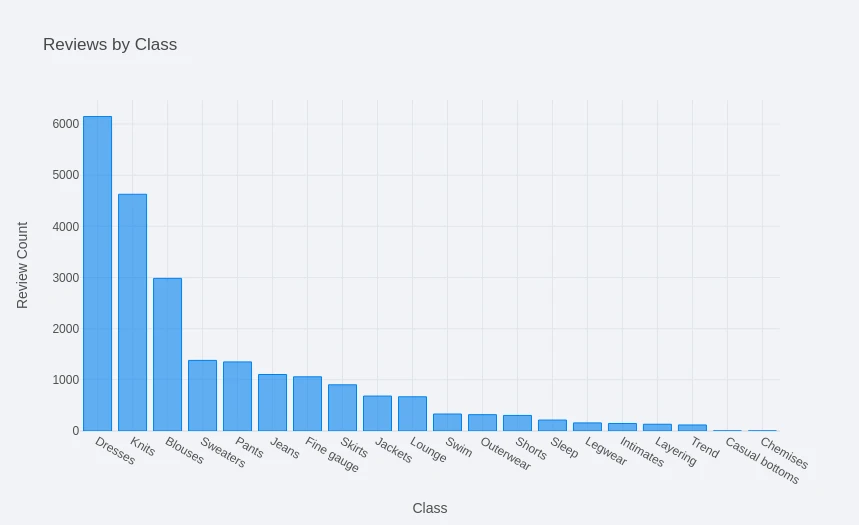
Unigram, Bigram and Trigram
Get Top Words Function
# pre-processing example - get word frequency from string
x = ['i would have, you would have ordered it online because it is petite. i bought a petite and am 5\'8\".']
vec = CountVectorizer().fit(x)
vec.vocabulary_.items()
# vocabulary items and position
# dict_items([('would', 10), ('have', 4), ('you', 11), ('ordered', 8), ('it', 6), ('online', 7), ('because', 2), ('is', 5), ('petite', 9), ('bought', 3), ('and', 1), ('am', 0)])
words = vec.transform(x)
words_sum = words.sum(axis=0)
words_sum
# frequency of words (correlates to position index above)
# matrix([[1, 1, 1, 1, 1, 1, 2, 1, 1, 2, 1]])
word_frequency = []
for word, idx in vec.vocabulary_.items():
word_frequency.append((word, words_sum[0, idx]))
word_frequency = sorted(word_frequency, key=lambda x: x[1], reverse=True)
word_frequency
# [('would', 2),
# ('have', 2),
# ('it', 2),
# ('petite', 2),
# ('you', 1),
# ('ordered', 1),
# ('online', 1),
# ('because', 1),
# ('is', 1),
# ('bought', 1),
# ('and', 1),
# ('am', 1)]
def get_ngrams_by_frequency(nrange, data, n):
# ngram_range : tuple (min_n, max_n), default=(1, 1)
vec = CountVectorizer(ngram_range=nrange).fit(data)
vec.vocabulary_.items()
words = vec.transform(data)
words_sum = words.sum(axis=0)
word_frequency = []
for word, idx in vec.vocabulary_.items():
word_frequency.append((word, words_sum[0, idx]))
top_words = sorted(word_frequency, key=lambda data: data[1], reverse=True)
return top_words[:n]
# return 5 top words
get_ngrams_by_frequency((1, 1), x, 5)
# [('would', 2), ('have', 2), ('it', 2), ('petite', 2), ('you', 1)]
Unigrams Feature Extraction
top_20_unigrams = get_ngrams_by_frequency(
nrange=(1, 1),
data=reviews_df_expanded['Review Text'],
n=20
)
top_20_unigrams_df = pd.DataFrame(top_20_unigrams, columns=['Unigram', 'Frequency'])
top_20_unigrams_df = top_20_unigrams_df.set_index('Unigram')
top_20_unigrams_df
| Unigram | Frequency |
|---|---|
| the | 76159 |
| it | 49162 |
| and | 48993 |
| is | 37696 |
| this | 25758 |
| to | 24592 |
| in | 20722 |
| not | 18781 |
| but | 16549 |
| on | 15325 |
| for | 13994 |
| of | 13472 |
| was | 12923 |
| with | 12797 |
| so | 12017 |
| am | 11625 |
| my | 11027 |
| dress | 10561 |
| that | 9560 |
| love | 8945 |
top_20_unigrams_df.iplot(
kind='bar',
theme='polar',
title='Top 20 Unigrams',
yTitle='Frequency',
xTitle='Unigram'
)
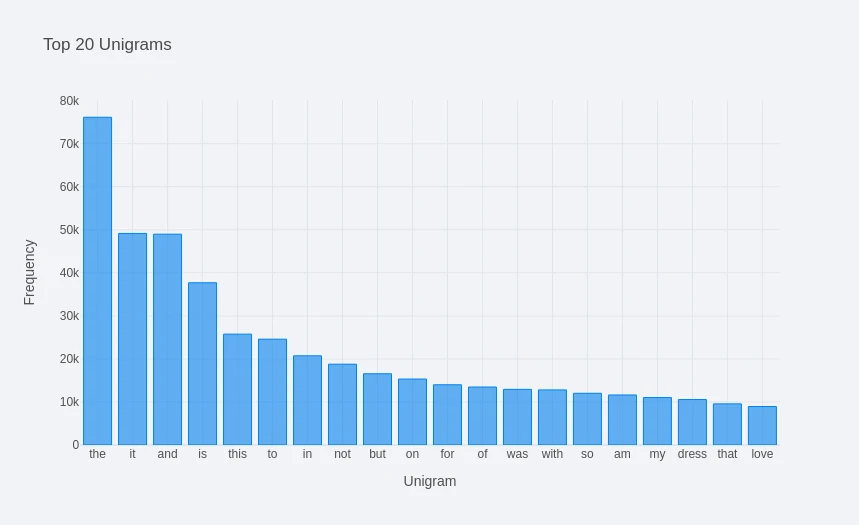
Bigrams Feature Extraction
top_20_bigrams = get_ngrams_by_frequency(
nrange=(2, 2),
data=reviews_df_expanded['Review Text'],
n=20
)
top_20_bigrams_df = pd.DataFrame(top_20_bigrams, columns=['Bigram', 'Frequency'])
top_20_bigrams_df = top_20_bigrams_df.set_index('Bigram')
top_20_bigrams_df
| Bigram | Frequency |
|---|---|
| it is | 12528 |
| in the | 7169 |
| and the | 5611 |
| this dress | 4755 |
| on the | 4337 |
| of the | 3933 |
| and it | 3723 |
| it was | 3287 |
| does not | 3228 |
| this top | 2937 |
| this is | 2772 |
| is very | 2725 |
| the fabric | 2653 |
| love the | 2641 |
| did not | 2486 |
| love this | 2331 |
| to wear | 2266 |
| but it | 2196 |
| the dress | 2178 |
| do not | 2118 |
top_20_bigrams_df.iplot(
kind='bar',
theme='polar',
title='Top 20 Bigrams',
yTitle='Frequency',
xTitle='Bigram'
)
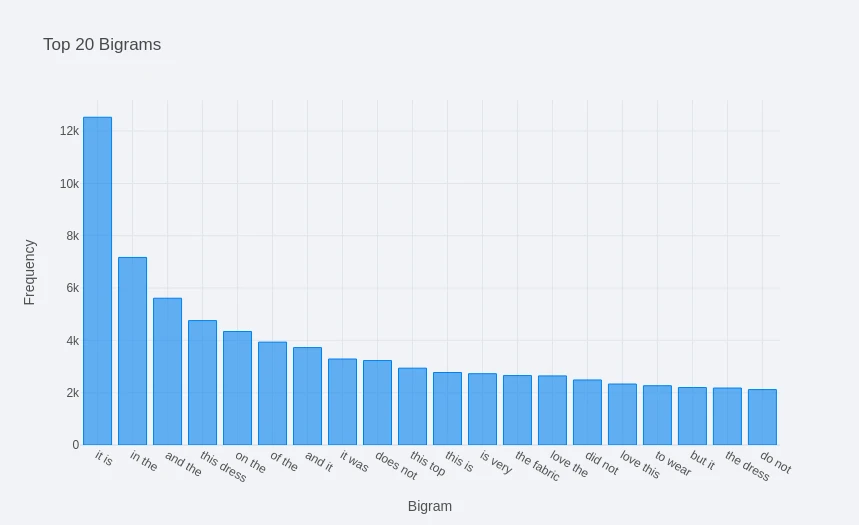
Trigrams Feature Extraction
top_20_trigrams = get_ngrams_by_frequency(
nrange=(3, 3),
data=reviews_df_expanded['Review Text'],
n=20
)
top_20_trigrams_df = pd.DataFrame(top_20_trigrams, columns=['Trigram', 'Frequency'])
top_20_trigrams_df = top_20_trigrams_df.set_index('Trigram')
top_20_trigrams_df
| Trigram | Frequency |
|---|---|
| do not does | 1759 |
| not does not | 1758 |
| true to size | 1316 |
| the fabric is | 1301 |
| and it is | 1124 |
| this dress is | 1123 |
| it is very | 976 |
| but it is | 921 |
| it is not | 910 |
| the material is | 896 |
| if you are | 733 |
| in the store | 728 |
| on the model | 722 |
| the fit is | 696 |
| this top is | 672 |
| the color is | 630 |
| love this dress | 603 |
| it is so | 585 |
| tried it on | 574 |
| and it was | 550 |
top_20_trigrams_df.iplot(
kind='bar',
theme='polar',
title='Top 20 Trigrams',
yTitle='Frequency',
xTitle='Trigram'
)
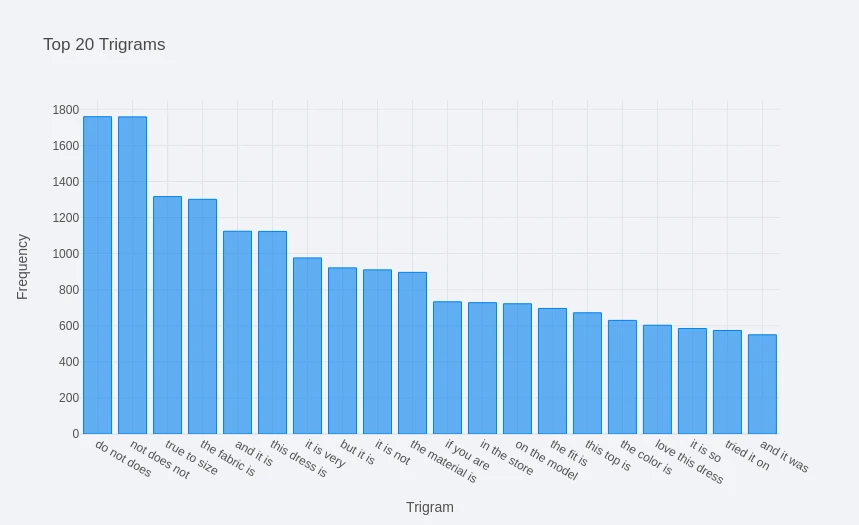
Removing Stop Words
def get_ngrams_no_stop_by_frequency(nrange, data, n):
# ngram_range : tuple (min_n, max_n), default=(1, 1)
vec = CountVectorizer(ngram_range=nrange, stop_words='english').fit(data)
vec.vocabulary_.items()
words = vec.transform(data)
words_sum = words.sum(axis=0)
word_frequency = []
for word, idx in vec.vocabulary_.items():
word_frequency.append((word, words_sum[0, idx]))
top_words = sorted(word_frequency, key=lambda data: data[1], reverse=True)
return top_words[:n]
top_20_unigrams_no_stop = get_ngrams_no_stop_by_frequency(
nrange=(1, 1),
data=reviews_df_expanded['Review Text'],
n=20
)
top_20_unigrams_no_stop_df = pd.DataFrame(top_20_unigrams_no_stop, columns=['Unigram', 'Frequency'])
top_20_unigrams_no_stop_df = top_20_unigrams_no_stop_df.set_index('Unigram')
top_20_unigrams_no_stop_df.iplot(
kind='bar',
theme='polar',
title='Top 20 Unigrams',
yTitle='Frequency',
xTitle='Unigram'
)
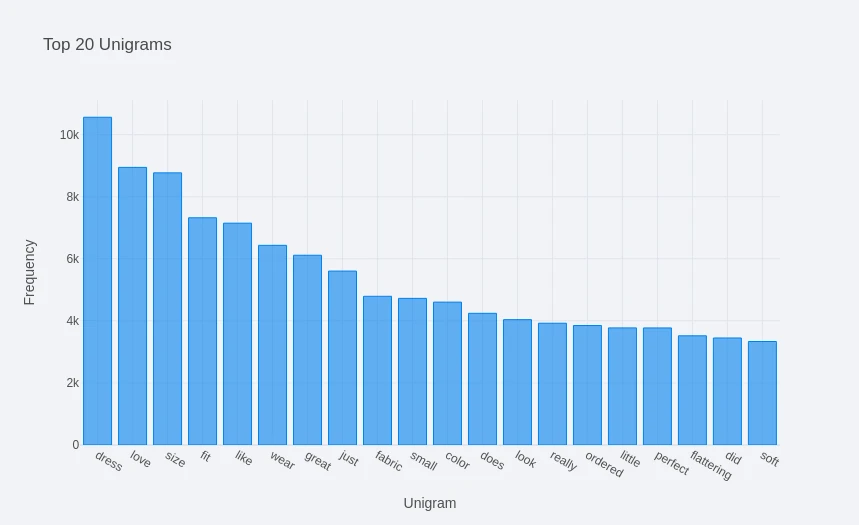
top_20_bigrams_no_stop = get_ngrams_no_stop_by_frequency(
nrange=(2, 2),
data=reviews_df_expanded['Review Text'],
n=20
)
top_20_bigrams_no_stop_df = pd.DataFrame(top_20_bigrams_no_stop, columns=['Bigram', 'Frequency'])
top_20_bigrams_no_stop_df = top_20_bigrams_no_stop_df.set_index('Bigram')
top_20_bigrams_no_stop_df.iplot(
kind='bar',
theme='polar',
title='Top 20 Bigrams',
yTitle='Frequency',
xTitle='Bigram'
)
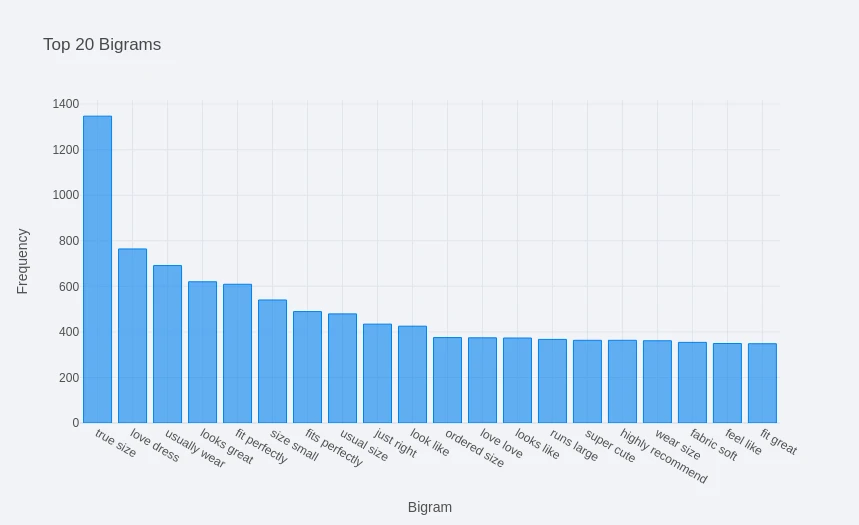
top_20_trigrams_no_stop = get_ngrams_no_stop_by_frequency(
nrange=(3, 3),
data=reviews_df_expanded['Review Text'],
n=20
)
top_20_trigrams_no_stop_df = pd.DataFrame(top_20_trigrams_no_stop, columns=['Bigram', 'Frequency'])
top_20_trigrams_no_stop_df = top_20_trigrams_no_stop_df.set_index('Bigram')
top_20_trigrams_no_stop_df.iplot(
kind='bar',
theme='polar',
title='Top 20 Trigrams',
yTitle='Frequency',
xTitle='Trigrams'
)

Parts-of-Speech (PoS-Tags)
nltk.download('averaged_perceptron_tagger')
nltk.download('punkt')
nltk.download('tagsets')
blob = TextBlob(str(reviews_df_expanded['Review Text']))
pos_df = pd.DataFrame(blob.tags, columns=['Words', 'PoS'])
pos_df
| Words | PoS | |
|---|---|---|
| 0 | 0 | CD |
| 1 | Absolutely | RB |
| 2 | wonderful | JJ |
| 3 | silky | NN |
| 4 | and | CC |
| ... | ||
| 106 | Text | NNP |
| 107 | Length | NNP |
| 108 | 22628 | CD |
| 109 | dtype | NN |
| 110 | object | NN |
| 111 rows × 2 columns |
nltk.help.upenn_tagset()
$: dollar
$ -$ --$ A$ C$ HK$ M$ NZ$ S$ U.S.$ US$
'': closing quotation mark
' ''
(: opening parenthesis
( [ {
): closing parenthesis
) ] }
,: comma
,
--: dash
--
.: sentence terminator
. ! ?
:: colon or ellipsis
: ; ...
CC: conjunction, coordinating
& 'n and both but either et for less minus neither nor or plus so
therefore times v. versus vs. whether yet
CD: numeral, cardinal
mid-1890 nine-thirty forty-two one-tenth ten million 0.5 one forty-
seven 1987 twenty '79 zero two 78-degrees eighty-four IX '60s .025
fifteen 271,124 dozen quintillion DM2,000 ...
DT: determiner
all an another any both del each either every half la many much nary
neither no some such that the them these this those
EX: existential there
there
FW: foreign word
gemeinschaft hund ich jeux habeas Haementeria Herr K'ang-si vous
lutihaw alai je jour objets salutaris fille quibusdam pas trop Monte
terram fiche oui corporis ...
IN: preposition or conjunction, subordinating
astride among uppon whether out inside pro despite on by throughout
below within for towards near behind atop around if like until below
next into if beside ...
JJ: adjective or numeral, ordinal
third ill-mannered pre-war regrettable oiled calamitous first separable
ectoplasmic battery-powered participatory fourth still-to-be-named
multilingual multi-disciplinary ...
JJR: adjective, comparative
bleaker braver breezier briefer brighter brisker broader bumper busier
calmer cheaper choosier cleaner clearer closer colder commoner costlier
cozier creamier crunchier cuter ...
JJS: adjective, superlative
calmest cheapest choicest classiest cleanest clearest closest commonest
corniest costliest crassest creepiest crudest cutest darkest deadliest
dearest deepest densest dinkiest ...
LS: list item marker
A A. B B. C C. D E F First G H I J K One SP-44001 SP-44002 SP-44005
SP-44007 Second Third Three Two * a b c d first five four one six three
two
MD: modal auxiliary
can cannot could couldn't dare may might must need ought shall should
shouldn't will would
NN: noun, common, singular or mass
common-carrier cabbage knuckle-duster Casino afghan shed thermostat
investment slide humour falloff slick wind hyena override subhumanity
machinist ...
NNP: noun, proper, singular
Motown Venneboerger Czestochwa Ranzer Conchita Trumplane Christos
Oceanside Escobar Kreisler Sawyer Cougar Yvette Ervin ODI Darryl CTCA
Shannon A.K.C. Meltex Liverpool ...
NNPS: noun, proper, plural
Americans Americas Amharas Amityvilles Amusements Anarcho-Syndicalists
Andalusians Andes Andruses Angels Animals Anthony Antilles Antiques
Apache Apaches Apocrypha ...
NNS: noun, common, plural
undergraduates scotches bric-a-brac products bodyguards facets coasts
divestitures storehouses designs clubs fragrances averages
subjectivists apprehensions muses factory-jobs ...
PDT: pre-determiner
all both half many quite such sure this
POS: genitive marker
' 's
PRP: pronoun, personal
hers herself him himself hisself it itself me myself one oneself ours
ourselves ownself self she thee theirs them themselves they thou thy us
PRP$: pronoun, possessive
her his mine my our ours their thy your
RB: adverb
occasionally unabatingly maddeningly adventurously professedly
stirringly prominently technologically magisterially predominately
swiftly fiscally pitilessly ...
RBR: adverb, comparative
further gloomier grander graver greater grimmer harder harsher
healthier heavier higher however larger later leaner lengthier less-
perfectly lesser lonelier longer louder lower more ...
RBS: adverb, superlative
best biggest bluntest earliest farthest first furthest hardest
heartiest highest largest least less most nearest second tightest worst
RP: particle
aboard about across along apart around aside at away back before behind
by crop down ever fast for forth from go high i.e. in into just later
low more off on open out over per pie raising start teeth that through
under unto up up-pp upon whole with you
SYM: symbol
% & ' '' ''. ) ). * + ,. < = > @ A[fj] U.S U.S.S.R * ** ***
TO: "to" as preposition or infinitive marker
to
UH: interjection
Goodbye Goody Gosh Wow Jeepers Jee-sus Hubba Hey Kee-reist Oops amen
huh howdy uh dammit whammo shucks heck anyways whodunnit honey golly
man baby diddle hush sonuvabitch ...
VB: verb, base form
ask assemble assess assign assume atone attention avoid bake balkanize
bank begin behold believe bend benefit bevel beware bless boil bomb
boost brace break bring broil brush build ...
VBD: verb, past tense
dipped pleaded swiped regummed soaked tidied convened halted registered
cushioned exacted snubbed strode aimed adopted belied figgered
speculated wore appreciated contemplated ...
VBG: verb, present participle or gerund
telegraphing stirring focusing angering judging stalling lactating
hankerin' alleging veering capping approaching traveling besieging
encrypting interrupting erasing wincing ...
VBN: verb, past participle
multihulled dilapidated aerosolized chaired languished panelized used
experimented flourished imitated reunifed factored condensed sheared
unsettled primed dubbed desired ...
VBP: verb, present tense, not 3rd person singular
predominate wrap resort sue twist spill cure lengthen brush terminate
appear tend stray glisten obtain comprise detest tease attract
emphasize mold postpone sever return wag ...
VBZ: verb, present tense, 3rd person singular
bases reconstructs marks mixes displeases seals carps weaves snatches
slumps stretches authorizes smolders pictures emerges stockpiles
seduces fizzes uses bolsters slaps speaks pleads ...
WDT: WH-determiner
that what whatever which whichever
WP: WH-pronoun
that what whatever whatsoever which who whom whosoever
WP$: WH-pronoun, possessive
whose
WRB: Wh-adverb
how however whence whenever where whereby whereever wherein whereof why
``: opening quotation mark
` ``
pos_df = pos_df['PoS'].value_counts()
pos_df
| NN | 23 |
| DT | 15 |
| JJ | 13 |
| CD | 11 |
| PRP | 8 |
| RB | 6 |
| VBZ | 5 |
| VBP | 5 |
| IN | 5 |
| CC | 4 |
| NNP | 4 |
| VBD | 4 |
| TO | 3 |
| NNS | 2 |
| VB | 2 |
| PDT | 1 |
| Name: PoS, dtype: int64 |
pos_df.iplot(
kind='bar',
theme='polar',
title='Parts-of-Speech',
yTitle='Count',
xTitle='Tags'
)
Bivariant Analysis
sns.pairplot(
data=reviews_df_expanded,
hue='Rating',
palette='winter'
)
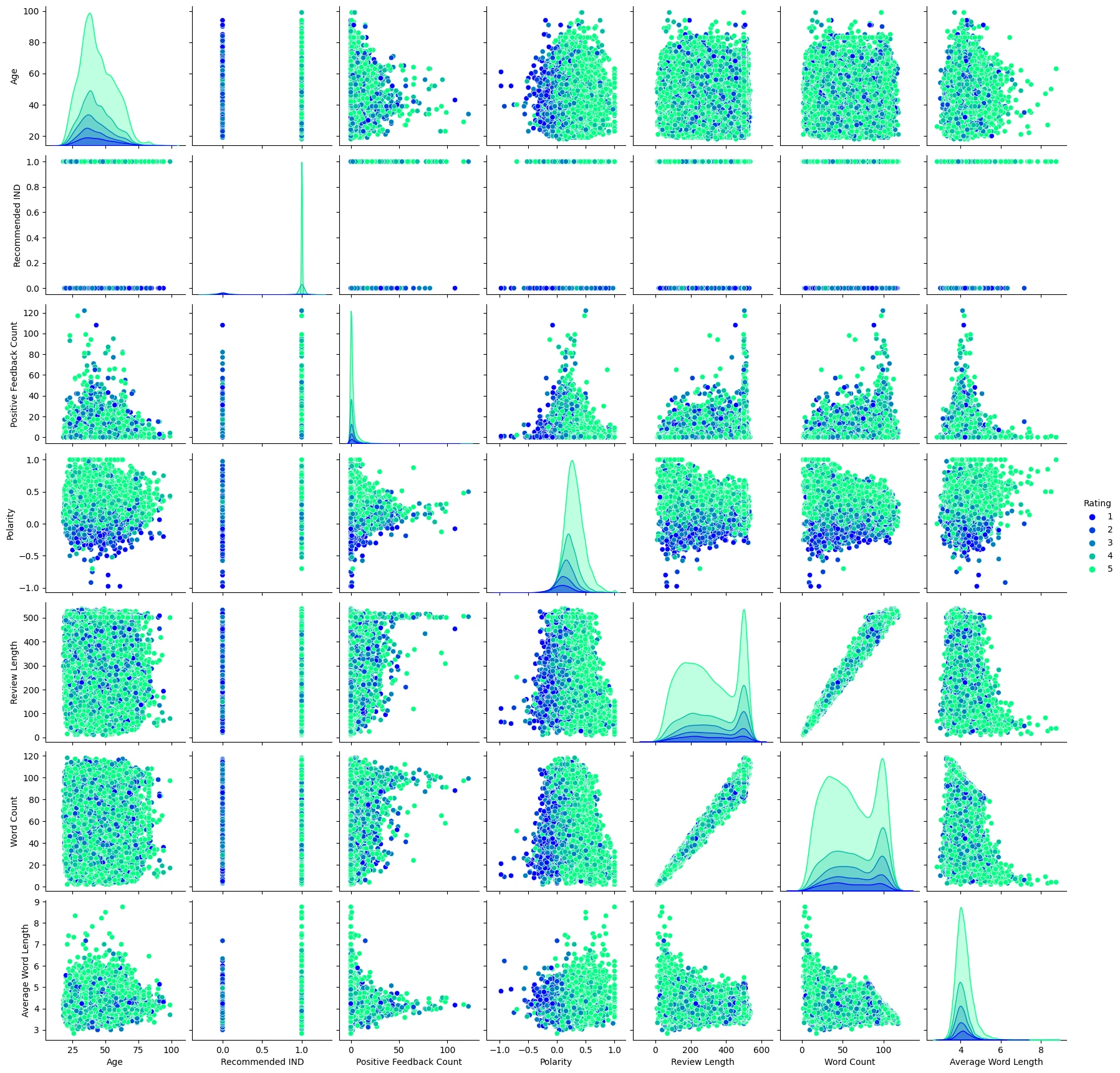
plt.rcParams['figure.figsize'] = [10,5]
sns.catplot(
data=reviews_df_expanded,
x='Department Name',
y='Polarity',
hue='Rating',
palette='winter',
height=5,
aspect=2
)
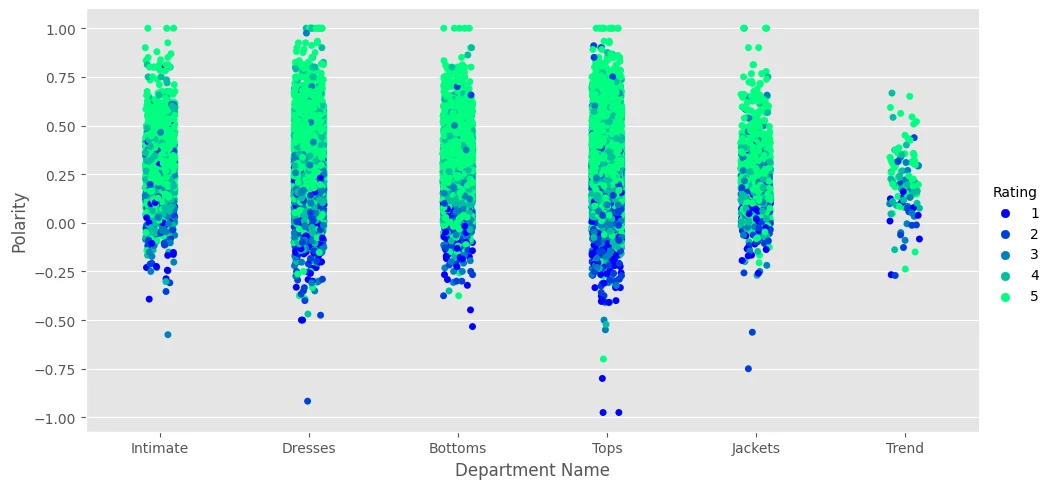
sns.catplot(
kind='box',
data=reviews_df_expanded,
x='Department Name',
y='Polarity',
hue='Rating',
palette='winter',
height=5,
aspect=2
)
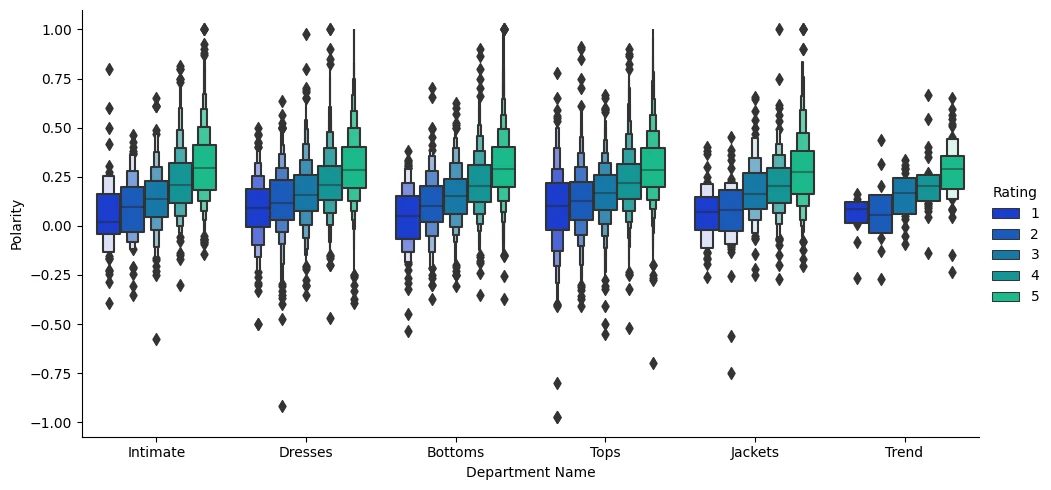
sns.catplot(
kind='box',
data=reviews_df_expanded,
x='Department Name',
y='Review Length',
hue='Rating',
palette='winter',
height=5,
aspect=2
)
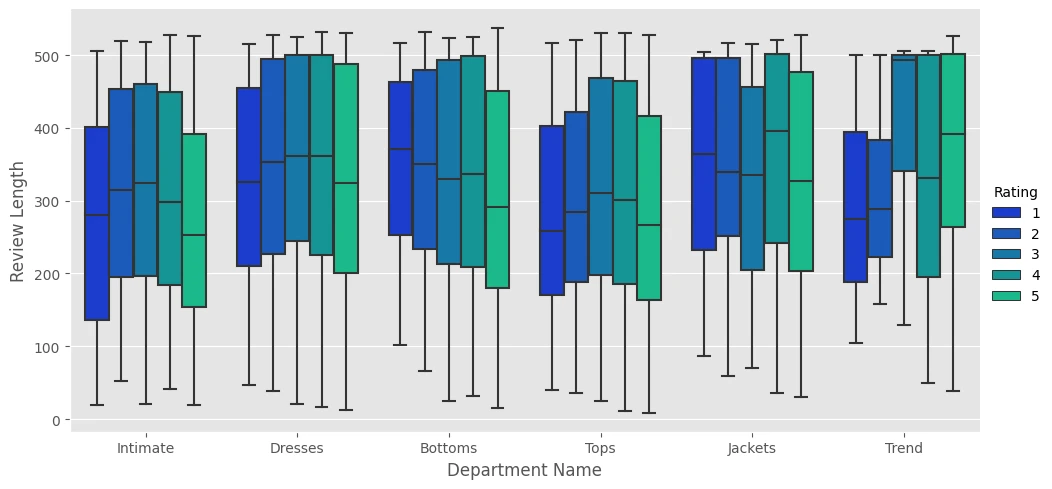
Recommendation Sentiment Polarity Distribution
recommended_ps = reviews_df_expanded[reviews_df_expanded['Recommended IND']==1]['Polarity']
recommended_ps.head(5)
| Polarity | |
|---|---|
| 0 | 0.633333 |
| 1 | 0.339583 |
| 3 | 0.550000 |
| 4 | 0.512891 |
| 6 | 0.133750 |
not_recommended_ps = reviews_df_expanded[reviews_df_expanded['Recommended IND']==0]['Polarity']
not_recommended_ps.head(5)
| Polarity | |
|---|---|
| 2 | 0.073675 |
| 5 | 0.178750 |
| 10 | -0.097149 |
| 22 | -0.045595 |
| 25 | 0.261508 |
trace_pos = go.Histogram(x=recommended_ps, name='Recommended', opacity=0.8)
trace_neg = go.Histogram(x=not_recommended_ps, name='Not Recommended', opacity=0.8)
data = [trace_pos, trace_neg]
layout = go.Layout(barmode='overlay', title='Recommendation Sentiment Polarity Distribution')
fig=go.Figure(data=data, layout=layout)
fig.data[0].marker.color = ('mediumspringgreen')
fig.data[1].marker.color = ('dodgerblue')
iplot(fig)
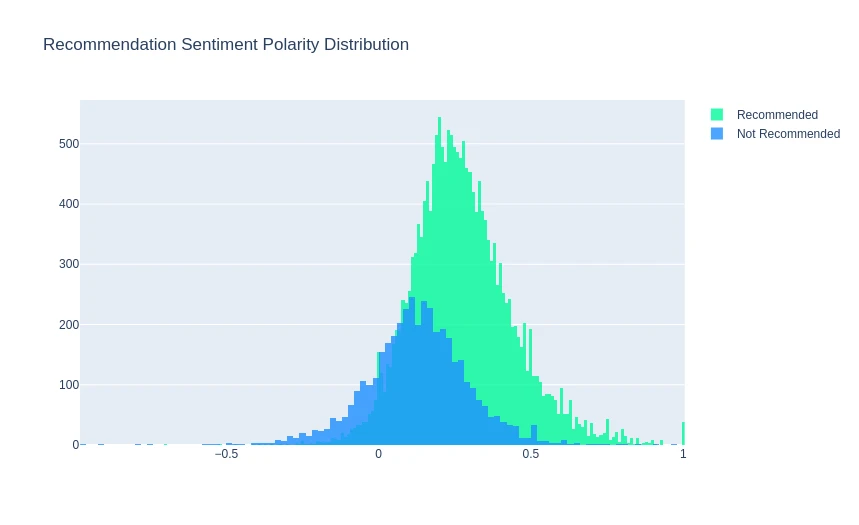
Recommendation Rating Distribution
recommended_rating_ps = reviews_df_expanded[reviews_df_expanded['Recommended IND']==1]['Rating']
not_recommended_rating_ps = reviews_df_expanded[reviews_df_expanded['Recommended IND']==0]['Rating']
trace_pos_rating = go.Histogram(x=recommended_rating_ps, name='Recommended', opacity=0.3)
trace_neg_rating = go.Histogram(x=not_recommended_rating_ps, name='Not Recommended', opacity=0.3)
data2 = [trace_pos_rating, trace_neg_rating]
layout2 = go.Layout(barmode='overlay', title='Recommendation Rating Distribution')
fig=go.Figure(data=data2, layout=layout2)
fig.data[0].marker.color = ('mediumspringgreen')
fig.data[1].marker.color = ('dodgerblue')
iplot(fig)
Joint Plot
sns.jointplot(
data=reviews_df_expanded,
y='Positive Feedback Count',
x='Polarity',
hue='Recommended IND',
palette='winter',
kind='kde',
fill=True
)
